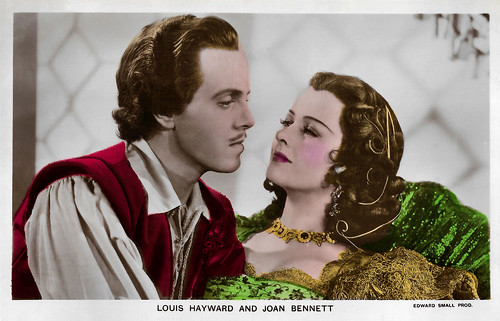
British postcard in the Film Partners Series, London, no. P. 306. Photo: Edward Small Prod. Louis Hayward and Joan Bennett in The Man in the Iron Mask (James Whale, 1939).
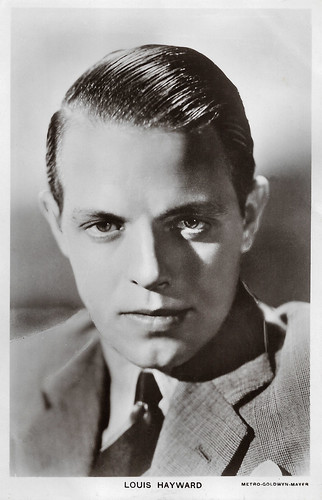
British postcard in the Picturegoer Series, London, no. 1119. Photo: Metro-Goldwyn-Mayer.

West German postcard by Starfoto Hasemann, no. 504. Photo: Paramount.
The first screen incarnation of Simon Templar
Louis Charles Hayward was born in Johannesburg, South Africa, in 1909, a few weeks after his mining engineer father was killed in an accident. Hayward was taken first to England and then to France, where he attended several schools under his real name, Seafield Grant. He received early training in legitimate theatre, appeared for a time with a touring company playing the provinces in England and then took over a small nightclub in London.
He became a protégé of playwright Noël Coward with whom he was also romantically involved. He began appearing in London in plays such as 'Dracula' and 'Another Language' and was also in the Sir Gerald du Maurier stage play, 'The Church Mouse'. He started being cast in some British films, such as the drama Self Made Lady (George King, 1932) with Heather Angel and the crime film The Man Outside (George A. Cooper, 1933) starring Henry Kendall. He had the lead role in the quota quickie Chelsea Life (Sidney Morgan, 1933) and supporting parts in Sorrell and Son (Jack Raymond, 1933) and the comedy I'll Stick to You (Leslie S. Hiscott, 1933) with Jay Laurier. On stage, he appeared in a Coward musical 'Conversation Piece' (1934) with the French star Yvonne Printemps and in the cinema, he had the lead in the romantic comedy The Love Test (1935), directed by Michael Powell.
Hayward went to Broadway in 1935 with a production of Coward's 'Point Valaine' working with Alfred Lunt and his wife Lynn Fontanne. The play, described as one of Coward's worst and poorly received critically and popularly, only ran for six weeks and was considered a failure. However, Hayward won the 1934 New York Critics Award. It was Hayward's only Broadway venture, but it brought him a Hollywood contract. He signed a four-picture deal with MGM. Hayward first played a supporting role in The Flame Within (Edmund Goulding, 1935), starring Ann Harding and followed that film with the melodrama A Feather in Her Hat (Alfred Santell, 1935), billed after Pauline Lord and Basil Rathbone. His first Hollywood efforts were moderately successful, moderately well-received and almost instantly forgotten.
Hayward's career started to gain momentum when he was cast in the extended romantic prologue of the expensive blockbuster Anthony Adverse (Mervyn LeRoy, 1936). William McPeak at IMDb: "As dashing officer Denis Moore, he was Anthony's father, rescuing his soon-to-be mother Maria from an arranged marriage to Marquis Don Luis, brilliantly played by Claude Rains. Shot with gauze focus in part to increase the dreamlike romantic interlude of the lovers, the prologue played to a bitter end with Hayward dispatched in a sword duel with the outraged Don Luis, and Maria, now pregnant, forced to return to her husband. However, Hayward had had his defining moment." Hayward's profile also was raised by his marriage to Ida Lupino. He was the male lead in the comedy The Luckiest Girl in the World (Edward Buzzell, 1936) with Jane Wyatt. Then he went to support Paul Muni and Miriam Hopkins in a love triangle in The Woman I Love (Anatole Litvak, 1937) and played the male lead of Midnight Intruder (Arthur Lubin, 1938) and Condemned Women (Lew Landers, 1938). Hayward was then cast as the first screen incarnation of Simon Templar in Leslie Charteris' The Saint in New York (Ben Holmes, 1938). The film was a hit and would eventually lead to a long-running series. However, the next five films in the series starred George Sanders as Templar. Hayward would eventually reprise the role in the British crime thriller The Saint's Return (Seymour Friedman, 1953). Hayward supported Danielle Darrieux and Douglas Fairbanks Jr. in The Rage of Paris (Henry Koster, 1938).
In 1938 Hayward starred in the drama The Duke of West Point (Alfred E. Green, 1938) for producer Edward Small, who signed him to make three films over the next five years. This meant that Hayward was unable to reprise his part as the Saint. However, Small started building Hayward into a star, casting him opposite Joan Bennett in a dual role as the good and evil royal twins Louis XIV and Philippe in the third volume in the Alexandre Dumas musketeer trilogy, The Man in the Iron Mask (James Whale, 1939). The Swashbuckler was a notable success. Hayward's good looks were complemented by an airy manner of speaking, which worked as both hero and rogue or occasional suave villain. Small put Hayward into My Son, My Son! (Charles Vidor, 1940) with Madeleine Carroll and Brian Aherne. In the comedy-drama Dance, Girl, Dance (Dorothy Arzner, 1940), he appeared with Maureen O'Hara and Lucille Ball. The film was a critical and commercial failure but later garnered a reputation as a feminist film. Small then put him in The Son of Monte Cristo (Rowland V. Lee, 1940), another Swashbuckler with Bennett and a sequel to The Count of Monte Cristo (Rowland V. Lee, 1934) starring Robert Donat. However, his swashbuckling efforts did not pan out as well as they did for Errol Flynn. Hayward then co-starred with his wife Ida Lupino in the Film Noir Ladies in Retirement (Charles Vidor, 1941). A bad break was his 1941 casting in a pivotal role in Orson Welles' The Magnificent Ambersons (1942), but his part was edited out of the final print.
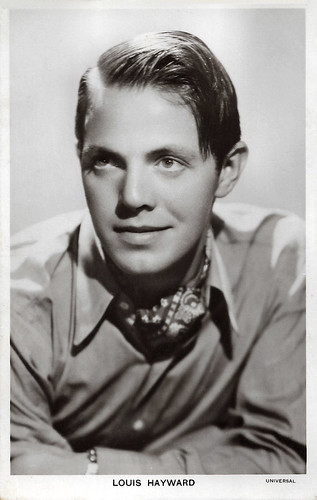
British postcard in the Picturegoer Series, London, no. 1119a. Photo: Eagle Lion.
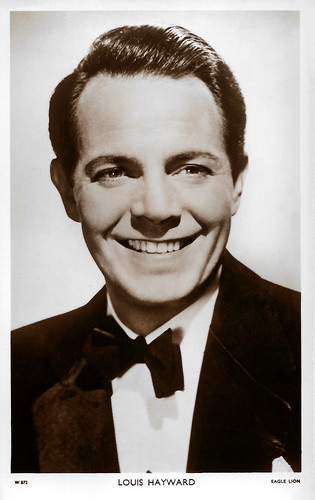
British postcard in the Picturegoer Series, London, no. W. 872. Photo: Eagle Lion.

Belgian postcard.
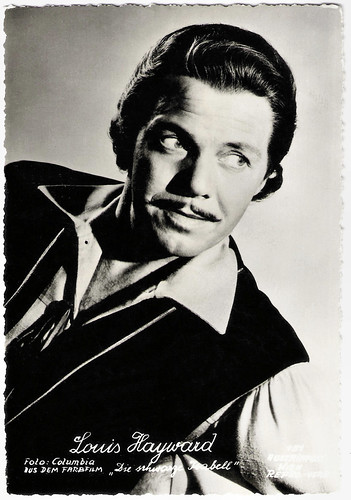
Austrian postcard by Austriapost, Wien, no. 151. Photo: Columbia. Louis Hayward in Captain Pirate (Ralph Murphy, 1952).
One of the first percentage-of-profit deals
Louis Hayward had become a naturalised U.S. citizen the day before the Japanese bombed Pearl Harbour. In July 1942, he enlisted in the United States Marine Corps. During World War II, he commanded a photographic unit that filmed the invasion of the Japanese-held island of Tarawa for the documentary With the Marines at Tarawa (Louis Hayward, 1944). The battle was one of the bloodiest in Marine history - three days of fighting cost the Marines nearly 3,000 casualties. Over 4,500 Japanese were killed. The carnage Captain Hayward saw would lead to depression and a complete physical collapse. His documentary won the 1944 Academy Award for Best Documentary Short Subject and Hayward was awarded the Bronze Star Medal for courage under fire. Overcoming the psychological stress of his war experiences, Hayward returned to the Hollywood spotlight.
He played Philip Lombard in the Agatha Christie thriller And Then There Were None (René Clair, 1945), which was a hit. For Hunt Stromberg, Hayward co-starred with Jane Russell in Young Widow (Edwin L. Marin, 1946) and supported Hedy Lamarr in the melodrama The Strange Woman (Edgar G. Ulmer, 1946). He returned to the Swashbuckler genre for Edward Small with Monte Cristo's Revenge (Henry Levin, 1947). Hayward made a Film Noir, Repeat Performance (Alfred L. Werker, 1947), then did another Swashbuckler, the Robin Hood-like Robert Louis Stevenson adventure The Black Arrow Strikes (Gordon Douglas, 1948).
Hayward played in Ruthless (Edgar G. Ulmer, 1948) with Zachary Scott, and then he did the anti-communist, Cold War Film Noir Walk a Crooked Mile (Gordon Douglas, 1948) for Small. Hayward went to Italy to make The Masked Pirate (Edgar G. Ulmer, 1949) for United Artists. He developed one of the first percentage-of-profit deals, ensuring him a steady income in perpetuity for both the theatrical and TV releases of his post-1949 films. Fritz Lang cast him in the lead of House by the River (1950) and he did the adventure films Fortunes of Captain Blood (Gordon Douglas, 1950) and The Lady and the Bandit (Ralph Murphy, 1951) with Patricia Medina. He also starred in the horror film The Son of Dr. Jekyll (Seymour Friedman, 1951), Lady in the Iron Mask (Ralph Murphy, 1951) again opposite Patricia Medina, and Captain Blood, Fugitive (Ralph Murphy, 1952), a sequel to Fortunes of Captain Blood.
Hayward began appearing on TV in Crossed and Double Crossed for The Ford Television Theatre (1952). He starred in and helped produce Storm Over Africa (Lesley Selander, 1953), and then he reprised his role as Simon Templar in The Saint's Return (Seymour Friedman, 1954), shot in Britain. In 1954, Hayward produced and starred in the 39-week television series The Lone Wolf (1954) after buying exclusive rights to several of Louis Joseph Vance's original 'Lone Wolf' stories. He did episodes of Matinee Theatre, Climax!, The O Henry Playhouse, The Highwayman, and Decision. In films, he was in The Search for Bridey Murphy (Noel Langley, 1956) with Teresa Wright. The film was inspired by the story of American Virginia Tighe, who believed herself to formerly have been Bridey Murphy, a nineteenth-century Irishwoman, in a case believed to be that of cryptomnesia. Hayward guest starred on series such as Riverboat and was in a TV production of The Picture of Dorian Gray (Paul Bogart, 1961) with George C. Scott. Hayward's work onstage included Noël Coward's 'Conversation Piece' and the national tour of 'Camelot' in which he appeared as King Arthur.
Hayward produced the British series The Pursuers (1961) and the American soap opera Harold Robbins' The Survivors (1969). Hayward's other television work includes the Alfred Hitchcock Hour, Kraft Television Theatre, Rawhide, and Burke's Law. Hayward's last films included the Westerns Chuka (Gordon Douglas, 1967) and The Christmas Kid (Sidney W. Pink, 1967). He also had roles in the film comedy The Phynx (Lee H. Katzin, 1970), and the mystery horror film Terror in the Wax Museum (Georg Fenady, 1973) with Ray Milland. His last appearance was in an episode of The Magician, titled The Illusion of the Lethal Playthings (1974). For his contributions to the motion picture and television industries, Hayward was honoured in 1960 with two stars on the Hollywood Walk of Fame at 1500 and 1680 Vine Street, respectively. Hayward married Ida Lupino in 1938 in a quiet civil ceremony held in the Santa Barbara courthouse. After he returned from the war, he was drastically different, which caused a strain on the marriage. They were divorced in 1945. He then met socialite Peggy Morrow, and after dating for a while, they married in 1946. They divorced four years later in 1950. Hayward had one son, Dana, with his third wife, June Hanson. Louis Hayward died in 1985 at the age of 75 in Palm Springs, California from lung cancer. Hayward publicly stated that his more than five-decade-long habit of smoking three packs of cigarettes daily was the likely cause of his cancer.
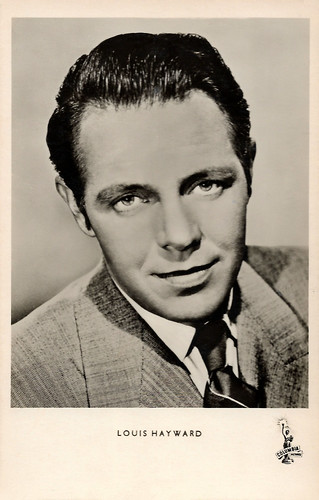
West German postcard by Kunst und Bild, Berlin, no. A 150. Photo: Columbia.

Dutch postcard, no. 3329. Photo: Europa-Columbia.
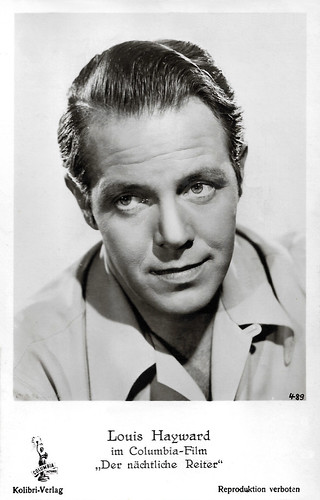
West German postcard by Kolibri-Verlag, Berlin, no. 489. Photo: Columbia. Louis Hayward in The Lady and the Bandit (Ralph Murphy, 1951).

British postcard in the Film Partners Series, London, no. P. 306. Photo: Edward Small Prod. Louis Hayward and Joan Bennett in The Man in the Iron Mask (James Whale, 1939).
Sources: William McPeak (IMDb), Ted Thackrey Jr. (Los Angeles Times), AllMovie, Wikipedia and IMDb.
This post was last updated on 30 August 2024.
No comments:
Post a Comment